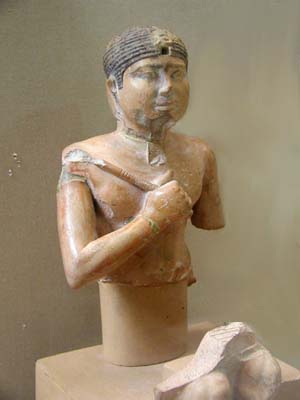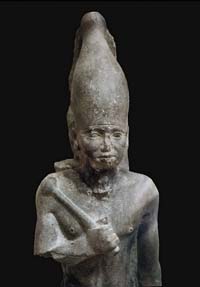Pharaoh Neferefre
Neferefre is not a well known Egyptian pharaoh. However, Egyptologists consider him the most documented ruler of the Fifth Dynasty. The artifacts and texts found within his mortuary temple shed light on many previously unknown aspects of Egyptian life in the Old Kingdom, including trade arrangements, business transactions and religious beliefs.
Royal Family
Egyptologists have no solid evidence on the actual year of Neferefre’s birth. As the son of the Pharaoh Neferirkare and Queen Khentkaus II, he began his reign at the death of his father in approximately 2460 B.C.

©Jon Bodsworth - Limestone statue of Neferefre
Neferefre held many names during his life, including:
- Ranefer
- Neferre
- Nefer-khau
- Nefer-em-nebty
- Netjer-nub-nefer
- Izi
- Lord of Stability
Modern historians believe Neferefre ruled for approximately two years. Inscriptions in his tomb speak of events during the second year of his reign. His estimated date of death is around 2458 B.C.
For thousands of years, historians have not known whether or not Neferefre married. In January 2015, Egyptian Antiquities Minister Mamdouh al-Damaty announced that Czech archaeologists recently uncovered a tomb in Neferefre’s funeral complex containing the mummy of a queen. Egyptologists identified the queen as Khentakawess III by the inscription of her name and rank on the tomb walls.
Limited Accomplishments
Historians know little of Neferefre’s life and accomplishments. His short reign limited the amount of work done under his name. He had just began work on his pyramid near his father and mother in Abusir at the time of his death.
Ancient texts indicate that Neferefre began building a sun temple under the guidance of the overseer Ti. The temple, known as Hotep-Re or “Re’s Offering Table,” has never been located.
Unfinished Pyramid
His early death resulted in the unfinished condition of the pyramid of Neferefre. Instead of becoming a pyramid, his tomb became simply a mastaba. Resembling a shortened pyramid, builders gave the structure sloped sides of approximately 78 degrees. Texts state that the tomb was known as the “Mound” by both the builders and members of the king’s funerary cult.
Tomb robbers unfortunately found Neferefre’s tomb as easy prey because of its limited size. Archaeologists found very few contents within the tomb. The tomb was lined and sealed with pink granite. It contained parts of a pink sarcophagus, alabaster Canopic jars, alabaster offering containers and the remnants of a mummy. Upon investigation, archaeologists believe the mummy to be that of King Neferefre. He was probably between 20 to 23 years old at the time of death.
Mortuary Temple
The completion of the tomb and the building of a mortuary temple became the responsibility of Neferefre’s successor. Texts reveal that a relative named Shepseskare ruled only for a few months after Neferefre. Archaeologist credit the work on Neferefre’s mortuary temple to the next pharaoh, King Niuserre. Instead of a traditional location, Neferefre's mortuary temple stretches alongside his unfinished pyramid. Known as “Divine are the souls of Neferefre”, the temple served as a home for the mortuary cult of the pharaoh into the Sixth Dynasty.
Within the temple were many fragments of Neferefre statues. Six statues were almost complete but damaged. The large number of papyri, frit tables and faience ornaments found within the temple’s storage magazines more than doubled the number of documents dating to the Old Kingdom. These discoveries allowed Egyptologists to reconstruct much of the unknown ancient Egyptian history.
Quick Facts
- Ruled for approximately 2 years.
- Little is known of his life or his reign.
- Died in his early 20's.
- Ongoing archaeological research continues to reveal more information regarding his family.

